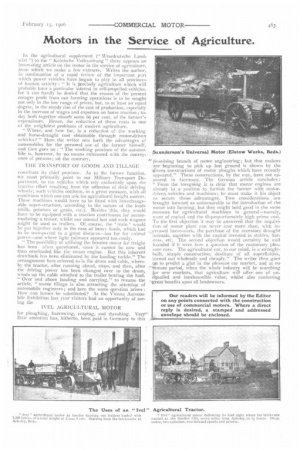Motors in the Service of Agriculture.
Page 19

If you've noticed an error in this article please click here to report it so we can fix it.
In the agricultural supplement (" Westdeutsche Land
wirt to the " Kiilnische ■'olkszeitung " there appears an interesting article on the motor in the service of agriculture, from which we make a few extracts. Writes the author, in continuation of a rapid review of the important part which power vehicles have begun to play in all provinces of human activity : " It is precisely agriculture which will probably have a particular interest in self-propelled vehicles, for it can hardly be denied that the reason of the present meagre profit from our farming operations is to be sought not only in the low range of prices, but, to at least an equal degree, in the steady rise of the cost of production, especially in the increase of wages and expenses on horse traction ; today both together absorb some 66 per cent, of the farmer's .expenditure. Hence, the reduction of these costs is one of the weightiest problems of modern agriculture. " Where, and how far, is a reduction of the working and horse-draught cost obtainable through motor-driven vehicles? " Here the writer sets forth he advantages of automobiles for the personal use of the farmer himself, and then goes On : " The working province of the automobile is, however, by no means exhausted with the conveyance of persons; on the contrary,
THE TRANSPORT OF GOODS AND TILLAGE
constitute its chief province. As to the former function, we must primarily point to our Military Transport Department, to the vehicles which rely exclusively upon the tractive effort resulting from the adhesion of their driving wheels; such vehicles conform, in a great measure, with all .conditions which one can ask for agricultural freight motors. These machines would have to be fitted with interchangeable super-structure, according to the nature of the loads (milk, potatoes or grain, etc.). Besides this, they would have to be equipped with a traction contrivance for accommodating a trailer, whilst our normal box and rack wagons .might be used as trailers. Of course, the ' train ' would be put together only in the case of heavy loads, which had to be transptd ted to a great distarce—too far for animal power—and where light railways appeared too costly.
" The possibility of utilising the benzine motor for freight has been often questioned, since it cannot be now and then overloaded like the steam engine. But this inherent .drawback has been eliminated by the hauling tackle." The arrangement here referred lo is the drum and cable, whereby the tractor, after running ahead, stops, and then, after the driving power has been changed over to the drum, winds up the cable attached to the trailer hearing the load. " Over and above hauling and carrying," to resume the article, " motor tillage is also attracting the attention of automobile engineers; and here the same question arises : flow can horses be substituted? At the Venna Automobile Exhibition last year visitors had an opportunity of seeing the 11,T.L AGRICULTURAL MOTOR
for ploughing, harrowing, reaping, and threshing. Verrlittie attention has, hitherto, been paid in Germany to this promising branch of motor engineering ; but that makers -are-beginning to pick up lost ground is shown by the divers constructions of motor ploughs which have recently appeared." These constructions, by the way, have not appeared in Germany. The German article concludes ; " From the foregoing it is clear that motor engines are already in a position to furnish the farmer with motordriven vehicles and machines; he must make it his object to secure theso 4dvantages. Two considerations are brought forward as unfavourable to the introduction of the motor into farming, but they might hold good in the same measure for agricultural machines in general—namely, want of capital and the disproportionately high prime cost. To the first objection it may be answered that the acquisition of motor plant can never cost more than, with increased horse-work, the purchase of the necessary draught -animals, together with the capital invested in stables, harness, etc. The second objection would certainly be well founded if it were here a question of the customary pleasure cars. The agricultural car, to our mind, is a stronglybuilt, simple construction, destitute of all superfluities, turned out wholesale and cheaply." The writer then goes on to predict a glut in the pleasure car market, and at no emote period, when the whole industry will be searching or new markets, that agriculture will offer one of un&quailed and inexhaustible value, whilst also conferring ..great benefits upon all landowners.




























